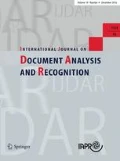Abstract
This paper describes a document recognition system for the modern neume based notation of Byzantine music. We propose algorithms for page segmentation, lyrics removal, syntactical symbol grouping and the determination of characteristic page dimensions. All algorithms are experimentally evaluated on a variety of printed books for which we also give an optimal feature set for a nearest neighbour classifier. The system is based on the Gamera framework for document image analysis. Given that we cover all aspects of the recognition process, the paper can also serve as an illustration how a recognition system for a non standard document type can be designed from scratch.
Similar content being viewed by others
References
Chrysanthos: Archbishop of Dirrachios: Μέγα Θεωρητικòν τη̂ϛ Βυζαντινη̂ϛ Μουσικη̂ϛ In: Panagiotis, G. (ed.) Pelopidis from Peloponnesos, Greece. Michele Weis, Tergest (1832)
Nicholas, N.: Unicode Technical Note: Byzantine Musical Notation. Version 1.1, February 2006. http://www.unicode.org/notes/tn20/ (2006)
Pugin, L.: Optical music recognition of early typographic prints using hidden Markov models. In: Proceedings of the 7th International Conference on Music Information Retrieval (ISMIR), pp. 53–56 (2006)
Barton, L.W.G., Caldwell, J.A., Jeavons, P.G.: E-Library of medieval chant manuscript transcriptions. In: Proceedings of the 5th ACM/IEEE Joint Conference on Digital Libraries, pp. 320–329 (2005)
Hiley D.: Western Plainchant: A Handbook. Oxford University Press, New York (1995)
Gezerlis V.G., Theodoridis S.: Optical character recognition of the orthodox Hellenic Byzantine music notation. Pattern Recognit. 35(4), 895–914 (2002)
Droettboom, M., MacMillan, K., Fujinaga, I.: The Gamera framework for building custom recognition systems. In: Symposium on Document Image Understanding Technologies, pp. 275–286 (2003)
Droettboom, M., et al.: The Gamera Project Homepage. http://gamera.sourceforge.net/ (2004–2008)
Dalitz, C., Michalakis, G.K.: Christine Pranzas: Psaltiki Toolkit for Gamera. http://psaltiki4gamera.sourceforge.net/ (2007)
Dalitz, C., Karsten, T.: Using the Gamera framework for building a lute tablature recognition system. In: Proceedings ISMIR 2005, pp. 478–481 (2005)
Canfield, K.: A pilot study for a Navajo textbase. In: Proceedings of The 17th International Conference on Humanities Computing and Digital Scholarship (ACH/ALLC), pp. 28–30 (2005)
Reddy, S., Crane, G.: A Document Recognition System for Early Modern Latin. Chicago Colloquium on Digital Humanities and Computer Science (2006)
Dalitz C., Droettboom M., Pranzas B., Fujinaga I.: A comparative study of staff removal algorithms. IEEE Trans. Pattern Anal. Mach. Intell. 30, 753–766 (2008)
Pal U., Chaudhuri B.B.: Indian script character recognition: a survey. Pattern Recognit. 37, 1887–1899 (2004)
Ma H., Doermann D.: Adaptive hindi OCR using generalized Hausdorff image comparison. ACM Trans. Asian Lang. Inf. Process. 2, 193–218 (2003)
Ha, T.M., Bunke, H.: Image processing methods for document image analysis. In: Bunke, H., Wang, P.S.P. (eds.) Handbook of Character Recognition and Document Image Analysis, pp. 1–47. World Scientific (1997)
Press W.H., Flannery B.P., Teukolsky S.A., Vetterling W.T.: Numerical Recipes in Pascal. Cambridge University Press, London (1993)
Gonzalez, R.C., Woods, R.E.: Digital Image Processing, 2nd edn. Prentice-Hall (2002)
Rosenfeld A., Pfaltz J.L.: Sequential operations in digital picture processing. J. ACM 13(4), 471–494 (1966)
Cattoni, R., Coianiz, T., Messelodi, S., Modena, C.M.: Geometric layout analysis techniques for document image understanding: a review. ITC-irst Technical Report TR#9703-09 (1998)
Mao S., Kanungo T.: Empirical performance evaluation methodology and its application to page segmentation algorithms. IEEE Trans. Pattern Anal. Mach. Intell. 23(3), 242–256 (2001)
Davies E.R.: Training sets and a priori probabilities with the nearest neighbour method of pattern recognition. Pattern Recognit. Lett. 8, 11–13 (1988)
Kothanzad A., Hong Y.H.: Invariant image recognition by zernike moments. IEEE Trans. Pattern Anal. Mach. Intell. 12, 489–497 (1990)
Droettboom, M.: Correcting broken characters in the recognition of historical printed documents. In: Joint Conference on Digital Libraries, pp. 364–366 (2003)
Brown L.D., Cai T.T., DasGupta A.: Interval estimation for a binomial proportion. Stat. Sci. 16(2), 101–117 (2001)
Casey R.G., Lecolinet E.: A survey of methods and strategies in character segmentation. IEEE Trans. Pattern Anal. Mach. Intell. 18(7), 690–706 (1996)
Good, M.: Lessons from the Adoption of MusicXML as an Interchange Standard. In: Proceedings of XML 2006 (2006). See also: http://www.musicxml.org/xml.html
Roland, P., Downie, J.S.: Recent developments in the music encoding initiative project: enhancing digital musicology and scholarship. In: 19th Joint Conference on the Digital Humanities, Conference Abstracts, pp. 186–189 (2007). See also: http://www.lib.virginia.edu/digital/resndev/mei/
Schräder, G.: Ein XML-Datenformat zur Repräsentation kritischer Musikedition unter besonderer Berücksichtigung von Neumennotation. Studienarbeit, Musikwissenschaftliches Institut der Universität Tübingen (2007). See also: http://www.dimused.info/
Papadopoulos, S.: Melodos—Byzantine Music Composer Software. http://www.melodos.com/ (2008)
Kise K., Sato A., Iwata M.: Segmentation of page images using the area Voronoi diagram. Comput. Vis. Image Underst. 70, 370–382 (1998)
Dengel, A., Hoch, R., Hönes, F., Jäger, T., Malburg, M., Weigel, A.: Techniques for improving OCR results. In: Bunke, H., Wang, P.S.P. (eds.) Handbook of Character Recognition and Document Image Analysis, pp. 227–258. World Scientific (1997)
Blostein D., Haken L.: Using diagram generation software to improve diagram recognition. IEEE Trans. Pattern Anal. Mach. Intell. 21, 1121–1136 (1999)
Tsang E.P.K.: Foundations of Constraint Satisfaction. Academic Press, London and San Diego (1993)
Author information
Authors and Affiliations
Corresponding author
Rights and permissions
About this article
Cite this article
Dalitz, C., Michalakis, G.K. & Pranzas, C. Optical recognition of psaltic Byzantine chant notation. IJDAR 11, 143–158 (2008). https://doi.org/10.1007/s10032-008-0074-4
Received:
Revised:
Accepted:
Published:
Issue Date:
DOI: https://doi.org/10.1007/s10032-008-0074-4




